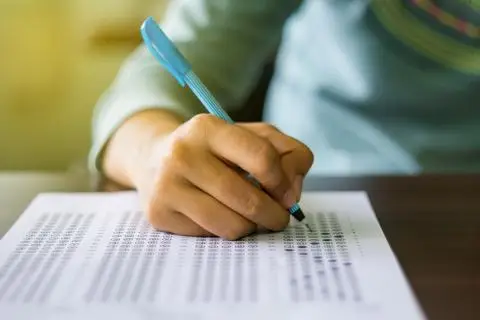In the familiar nursery rhyme, Humpty Dumpty fell off a great wall and couldn’t be put back together again. After being broken apart by COVID-19, will public education be like Humpty, or can it be put back just as it was? The latter possibility seems simple enough: Wait until the pandemic is over and then, after a year of coping, bring all the students and teachers back into schools as if the shutdown had never happened.
But it won’t be so simple. The shutdown has caused new conflicts among and between parents, teachers, employers, and district leaders, as all negotiate the details of remote learning and whether schools should begin to offer in-person instruction. The crisis has also amplified long-brewing conflicts about inequitable funding and access to quality teachers and effective instruction, as the differences between educational “haves” and “have-nots” have widened.
For now, public education is in chaos, with different schooling combinations of in-person hybrid, fully remote, and plain homeschooling evident—sometimes all in one locality. The politics now and in the foreseeable future will be fierce, just as we predicted in an earlier Chalkboard post. Even when the health crisis wanes, there will be pressures in two directions: one to put the old arrangements back into place just as they were before the pandemic hit, and the other to keep the crisis adaptations that have worked, at least for some students and their families.
Colliding pressures
We think a return to the pre-coronavirus status quo will prove impossible. Yes, there are strong pressures for a complete return to the pre-pandemic normal. According to CIVIS Analytics, of the families whose children enrolled in new options as a result of the pandemic, 82% say they would like to return to their pre-COVID-19 school once the crisis is over. States, by holding school districts harmless against enrollment losses suffered this year, are making sure the old arrangements don’t collapse. Some crisis adaptations, such as learning pods for children who need help and supervision when schools are not open, depend on private investments that might dry up once the crisis is over.
But there are serious barriers to putting everything back just as it was. The pre-COVID-19 school system was a product of years of small deals, governing everything from curriculum textbook contents to district budgets to the choice of holidays. These deals reflect the politics of days gone by. Today’s politics are very different.
No longer are school districts and teachers’ unions the only arbiters of instruction. Left without safe supervision and effective teaching, advantaged families are turning to private schools, homeschooling, and pandemic pods to fill the gaps. Families, long relegated to the outside of education, are by necessity playing a central role in shaping their children’s education. School leaders and teachers have adapted to the demands of remote learning by identifying new strategies to engage parents and students. Long-standing assumptions about when, where, and how instruction must occur are shifting in ways that make it impossible to simply return to “normal.”
New politics continue after 2020-2021
Coronavirus-based disruptions to schools could continue until at least 2024, and worries about contagion will not go away. Lack of trust among parents about vaccinations and health practices, and worries about especially vulnerable children and teachers, will persist beyond this school year. When students do eventually return to the classroom, parents, teachers, and school systems will confront the reality of missed learning and trauma that will necessitate something other than a simple restart. Advantaged and disadvantaged families alike could demand new investments in small learning communities like pods, tutoring, and emotional support they have come to trust.
At the same time, districts will be struggling with declining enrollment and revenue losses due to the recession. If large numbers of advantaged families who have fled to schooling options outside of public education don’t return, districts won’t have the money to return to normal. Larger urban districts, in particular, will face mismatches between their central office structures and teacher corps as well as the demands and expectations of families.
Teachers’ unions have been strong opponents of a quick return to in-person schooling, but they also have a strong stake in continuing arrangements that leave negotiations over schooling behind closed doors and protect traditional uses of funds and teachers. Unions will eventually want a return to the old normal, but their memberships will likely be divided, with some teachers fearing a return to in-person schooling, some preferring new methods of instruction developed during the pandemic, and others favoring a return to in-person school. Whether teachers’ unions can hold together will depend upon school systems’ mounting effective responses to the crisis in the years to come that meet the changing needs of students, parents, and even teachers themselves.
State and local leadership also have a role to play in what happens next. States that are now requiring schools to reopen, largely led by Republicans, provide some political cover to local district leaders fighting unions’ resistance to in-person instruction. But partisan pressures might weaken after the election posturing ends. Even if partisan state pressures continue, these can’t bypass conflicts among parents and teachers, or prevent enrollment losses. Nor will state pressures stop families, teachers, and school leaders from testing new approaches to deal with day-to-day realities and learning from the results.
What could emerge
Horses and men couldn’t put Humpty back together, but good, new things can be built from parts. Forward-looking districts are using this moment to develop creative new possibilities, such as expanding access to their most-effective teachers via remote learning, building new learning communities to serve small groups of students in person, and expanding access to services like tutoring, mentoring, counseling, and enrichment. Some families, left with few options, have charted new paths by forming pods, joining microschools, and taking a much bigger role in ensuring their children have access to adequate instruction and social-emotional supports. Some are assembling their own combinations of in-person and online learning experiences. These efforts could supplement traditional schools or in some cases replace them.
Local leaders who can use this moment to test new approaches to delivering instruction and build new sources of political support will be better positioned to build on these approaches after the COVID-19 crisis. Regardless of how long or short a time the current pandemic lasts, the “normal” in politics and schooling is unlikely to return anytime soon.
The piece originally appeared in Brookings’ Brown Center Chalkboard.





